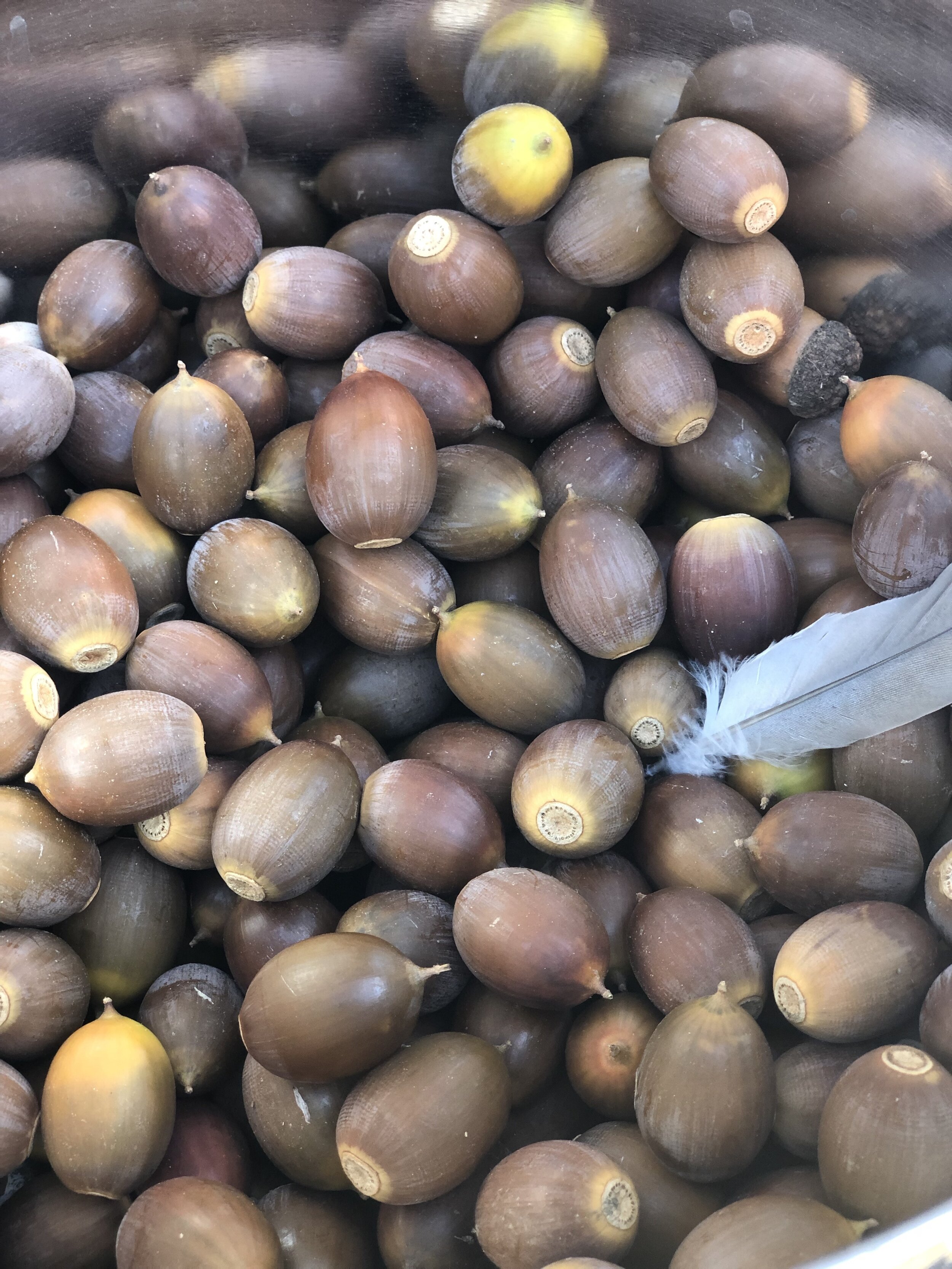Leaching Acorns
There are as many ways to leach acorns as there are tribes that eat acorns. The Karuk would dry the acorns for a year, crack the shells with rocks, pound them into meal, put the meal in the center of a pile of river sand, and leach them with water, letting the tannins drain into the sand. I use a Vitamix and glass jars. Adaptability is a cornerstone of Native ingenuity is what I always say.
Step 1:
These are White Oak/Garry Oak acorns from Hoopa
Get a bunch of acorns. But make sure they’re fertilized acorns. If the acorns are very small, and you can squeeze them firmly and the shell gives way, that means there’s no nut inside. You can also take a knife and cut one open, but the squeeze test works pretty well.
You’ll also want to tune in to the rhythm of your oaks. Are they dropping more acorns one year and less so another? That’s a normal oak cycle. And once you access that rhythm you’ll be able to prepare for those years. You’ll also notice that the first acorns to fall are usually the buggy ones that are heavy with moth larvae. It’s best to gather them up for the burn pile, to reduce infestation for the next year. There will be a second drop of acorns and those are the ones you want to gather. Any acorn can be made edible with the right amount of leaching, some just take longer than others.
Now that you have a bunch of acorns…
Step 2:
Sort out the buggy ones. Throw out any acorns that have a bore hole/holes, they’re carrying moth grubs. If you want you can eat the grubs, but I’m not that NDN. #britneyspears.gif
You can also pour all of your acorns into a tub of water and throw out the floaters. Just be sure to lay the acorns out to dry thoroughly otherwise the moisture will encourage mildew. If you’d like to jumpstart the drying process, put them in an oven on the lowest setting with the oven door propped open with a wooden spoon. Once they’re dried (you’re going to have to judge this for yourself, keep an eye on them), you can put them in a basket and let them sit until you want to use them, or you can start cracking and cleaning them for leaching.
Step 3:
Cracking & cleaning is the time I like to really think about how important this staple food was to our ancestors. Imagining the sound of acorns being cracked every morning, echoing up and down the river would have been something to behold. It’s also a good time to sit around with your family laughing and telling stories together.
I use a little machine to crack the acorns one at a time. I know industrial sized grinders exist, but I like to inspect every individual acorn and make sure all of the red testa is removed. I’m sure this will get old and eventually I’ll upgrade, but right now I use my cracker and a chestnut knife and they work for me. You can also use a hammer and a blanket to crack the acorns (put the acorns under the blanket), and clean them with a paring knife. A walnut pick isn’t a thin enough utensil to be effective. Often after drying, the red testa will come off with some rubbing and you don’t need to clean up as much, the acorn will feel kind of rubbery.
As I’m cracking, I throw the nuts into a jar half full of water to keep them from darkening.
Step 4:
Once you have a blender sized jar of peeled acorns and water, put them in your blender and grind them into a milkshake. The finer the grind, the easier it is to leach I’ve found. Pour your blender of acorn milkshake into a jar, cover the top of the jar with cheesecloth, and put it in the refrigerator. Once the meal settles to the bottom you’ll start to see dark tannin water at the top.
Acorn meal straight from the blender
Tannins leaching to the top, a middle band of acorn fat, and the acorn meal settling on the bottom
Pour off the tannin water, through the cheesecloth to keep your good fats & meal inside the jar, then refill with cold water, stir or shake it up, and put it back in the fridge. Sometimes I rinse out the cheesecloth, and put it back on, and/or wipe around the inside of the jar to keep any molds from growing on those areas that aren’t covered in water. I pour off once a day but you can do as many times as you are able. After a few days your tannins will fade and you’ll want to taste the meal. It should smell like almond milk and it may taste good for a second but then those bitter tannins will kick in. Just keep leaching, eventually you’ll just have a soft nutty, earthy flavor.
Step 5:
Now the tannins are all leached out, line a bowl with cheesecloth and pour the contents of your jar into the bowl. Pull up the sides of the cheesecloth, and strain the acorn milk out of the meal into a ball. You can drink acorn milk, put it in your coffee, mix it with some roasted pepper nut powder for cocoa, it’s delicious but very perishable. Once you have a strained ball of meal you have some options.
You can dry it up to rehydrate at another time (this is how you make flour), or you can make soup with it immediately, or you can freeze the meal and decide another time.
If you have a dehydrator with fruit roll silicone donuts, you can use that to dry out the meal, and then when it’s completely dry put it in the blender or a spice grinder and blitz it until it’s fine flour.
Squeezed acorn meal, ready to go in a dehydrator, or to be cooked.
Dehydrated, blitzed acorn flour! TADAAA Pat yourself on the back if you made it this far because I know it’s a lot of work and your ancestors are so proud of you, you’re everything.






